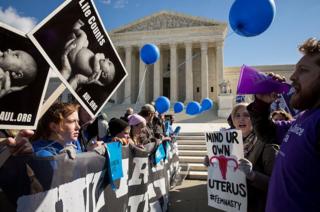 Image copyright
Image copyright
Getty Images
Pro-choice and anti-abortion activists outside the US Supreme Court
Abortion rates have fallen to their lowest level since the pregnancy-terminating procedure was legalised in a 1973 Supreme Court decision, according to a new report. But experts say the reason for the decline can be hard to isolate.
The study released on Wednesday by the Guttmacher Institute – a research organisation that supports abortion access – found a 7% decline from 2014 to 2017.
In 2017, around 862,320 abortions were performed, the group estimates – nearly 200,000 fewer than in 2011 and down from a high of 1.6m in 1990.
Despite nearly a decade of efforts by conservative state and county politicians to restrict abortion access, Guttmacher says the decline is not necessarily linked to new laws.
So what are some of the theories for the record-low US abortion rate?

Media playback is unsupported on your device
Better reproductive healthcare
The authors of the Guttmacher report – which is periodically compiled based on hospital and abortion clinic surveys – found that one reason for the decrease could be due to better access to contraception and improvement in female contraception devices.
Intrauterine devices and implants have improved in the past decade and are increasingly covered by insurance companies due to the 2009 Affordable Care Act (ACA), also known as Obamacare.
Elizabeth Nash, a policy manager for the Guttmacher Institute, says that the ACA, along with other local legislation, has increased access to birth control.
She cautions that the report shows the national average, but does not tell individual stories. For example, although the average distance women travelled for an abortion in 2014 was 34 miles (55km), some women were forced to travel much further for the same procedure.
“Some people are going hundreds of miles while some people are living in cities where they can take the bus or the train,” she says.
At-home abortions
Women are also turning to at-home medical abortions rather than surgery, the report says, noting that 95% of all documented procedures still take place in specialised clinics.
Abortions performed outside a clinic are harder or impossible to track, and could help explain the drop.
Image copyright
Getty Images
Medical abortions, which use the so-called abortion pill, accounted for 39% of abortions in 2017, up from 20% in 2014.
Nearly four in 10 abortions in 2017 were performed using abortion pills instead of surgery, the report notes.
Increased legal restrictions
Between 2011 to 2017, 32 states enacted a total of 394 new restrictions on abortion. Some of the harshest restrictions to date were passed by conservative-leaning states in 2018, after the latest Guttmacher survey was conducted, but several of those restrictions have been temporarily blocked by the courts.
Anti-abortion advocates cheered the declining rate as proof that regional laws are working to prevent abortions.
“I think they are having an impact,” says Laura Echevarria of the anti-abortion National Right to Life Committee. “If it’s not having a huge impact then why is everyone in the abortion industry up in arms every time a law is passed?”

Media playback is unsupported on your device
However, Ms Nash from Guttmacher says that while the regional restrictions “certainly play a role” in the national rate drop, “the numbers don’t tell the whole story”.
“The abortion rate, whether it declines or increases, is not really the indicator of access. What we need to do is think about what abortion services look like for each individual and whether or not they’re affordable and available.”
Some states that passed abortion restrictions between 2014-2017 actually saw increases in abortion rates. And in several states that opened new clinics, abortion rates went down. Overall, the US saw a net gain of abortion clinics in the three years covered by the report – however, several clinics have closed since 2017.
Lower birthrates
Women are choosing to have fewer children, with US birth rates at their lowest level since 1987, according to US government data released last year.
Both the birth rate – the number of births per thousand – and fertility – a lifetime average forecast – fell to their lowest level in 30 years, according to the 2018 report.
The decrease in births is being attributed in part to more women seeking higher education and employment, according to US researchers.
Other possible explanations could include changing societal expectations, increased access to contraception and limited provision for parental leave from work.
Increased awareness of pregnancy
Anti-abortion groups such as the National Right to Life Committee concede that the Guttmacher data is accurate, due to its close relationship with many abortion providers.
“The pro-life movement’s efforts to educate American’s about the humanity of the unborn child and pass protective pro-life legislation are having an impact,” says NRLC president Carol Tobias.
“Knowledge of what happens inside the womb” has become mainstream, NRLC Laura Echevarria spokeswoman adds, pointing to a recent Super Bowl advert that shows an ultrasound of an unborn child hungering for snack food.












